Baseball Card Sets – 1972 Topps
Every year Topps Baseball Cards changes their design. My baseball card collection covers ninety-five years, so each time I review my cards it’s like flipping through a massive Rolodex of colors, graphics, designs, paper stocks and styles. With this post I’m introducing a new category: Baseball Card Sets. I’m going to start with the 1972 Topps set, getting the negatives out-of-the-way and finishing on an uptempo note.
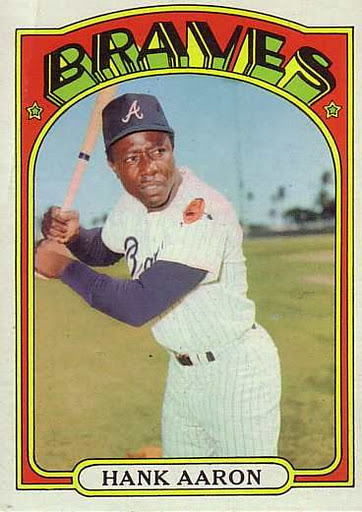 I suppose the lesson of the 1972 Topps set is that every company is good for a clunker from time to time. Here’s Hank Aaron’s card. Note the Hall of Fame player on a Sally League (extinct minor league whose players lacked significant talent) format. It’s a nice photo. The rest of the card is a disaster. The way the team name bursts forth from the top of the card draws this viewer’s attention away from the player. The whole purpose of a baseball card is to showcase the player. Maybe Topps thought its customers would be so blinded by the overall effect that they wouldn’t notice the player’s position was excluded from the card’s front. The colors are garish, too. How many times have you dreamed of remodeling a room in your home with a combination of red, yellow, green and black?
I suppose the lesson of the 1972 Topps set is that every company is good for a clunker from time to time. Here’s Hank Aaron’s card. Note the Hall of Fame player on a Sally League (extinct minor league whose players lacked significant talent) format. It’s a nice photo. The rest of the card is a disaster. The way the team name bursts forth from the top of the card draws this viewer’s attention away from the player. The whole purpose of a baseball card is to showcase the player. Maybe Topps thought its customers would be so blinded by the overall effect that they wouldn’t notice the player’s position was excluded from the card’s front. The colors are garish, too. How many times have you dreamed of remodeling a room in your home with a combination of red, yellow, green and black?
Back in the day, the colors on the front frequently changed from card to card. Different colors provided contrast and were used to connect players to their teams, so all of “your” players were framed in the same color. However, I believe the colors used in 1972 were brutal. Here’s a few to help you judge for yourself.
Some cards give you an orange, green, black and blue combination. Still others join red, orange, yellow and black. For those of you who have longed to see the color pink on a baseball card, Topps has you covered here as well.
Consisting of 787 cards, the set is so vast that there have to be some nice ones and there are. In all fairness, even clunker sets contain some beautiful cards. The sub set on the 1971 playoffs shows that the same format, without the psychedelic style of name at the card’s top, is certainly better.
Subsets abound in the 1972 edition. A sixteen-card subset of “Boyhood Photos of the Stars” is a hit. Topps gets high marks here for the way they told us about each of these future major league players.
**********************************************************************************************************************
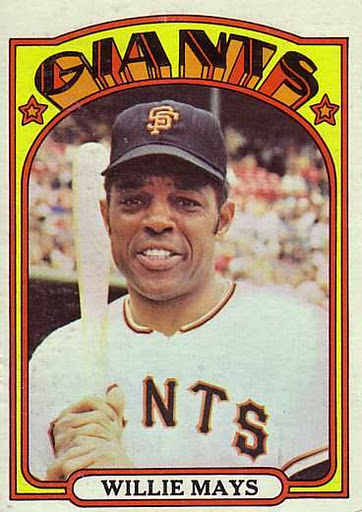 Here’s my favorite card from the set. This was Willie Mays’ last card in a Giants uniform. Every one knew he was near the end here, including his old fans in New York City. The owner of the New York Mets, Mrs. Joan Whitney Payson, was one of them. She asked if he could be brought to the Mets so he could finish his career where it started, in New York City, and a trade was made.
Here’s my favorite card from the set. This was Willie Mays’ last card in a Giants uniform. Every one knew he was near the end here, including his old fans in New York City. The owner of the New York Mets, Mrs. Joan Whitney Payson, was one of them. She asked if he could be brought to the Mets so he could finish his career where it started, in New York City, and a trade was made.
Switching back to the 1972 Topps set once again, in my view it’s a failed attempt to combine various color combinations with bold graphics to produce an exciting, contemporary card that is pleasant to look at. It’s not. It’s exhausting to look at for an extended period of time.
But the backs are well written, and there’s just as many of them. There are some old friends here, such as the ubiquitous “Hey Kids” cards. But there are also thoughtful subsets on the back sides of the cards, among them the well-received “So You’re A Baseball Expert” questions and the “Baseball’s Biggest Trades” series.
Reviewing my thoughts now, before I publish this post, I’ve clearly learned something from my research. If I don’t like the front of the card, just flip it over! Maybe my 1972 Topps Set “glass” is half full after all? To quote Mel Allen, “how about that?”
**********************************************************************************************************************
 Roberto Clemente was one of the most talented ball players to ever grace a baseball diamond. He would not live to see the 1973 season. This poignant card shows the Hall of Famer in a reflective mood. The photographer has captured a profoundly touching moment, one that shows him revealing a part of himself, as if he had an awareness that this would be the last baseball card he would pose for. On December 31, 1972, Roberto Clemente died in a plane crash while bringing desperately needed supplies to people in Nicaragua who had lost everything in a devastating hurricane.
Roberto Clemente was one of the most talented ball players to ever grace a baseball diamond. He would not live to see the 1973 season. This poignant card shows the Hall of Famer in a reflective mood. The photographer has captured a profoundly touching moment, one that shows him revealing a part of himself, as if he had an awareness that this would be the last baseball card he would pose for. On December 31, 1972, Roberto Clemente died in a plane crash while bringing desperately needed supplies to people in Nicaragua who had lost everything in a devastating hurricane.


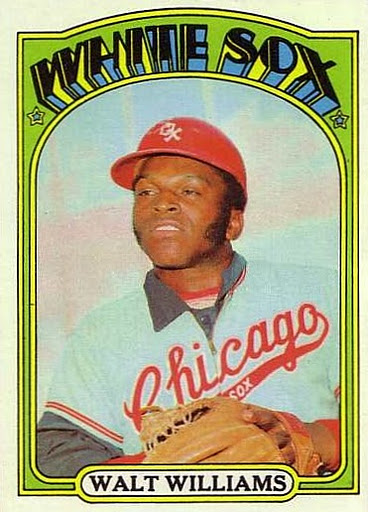

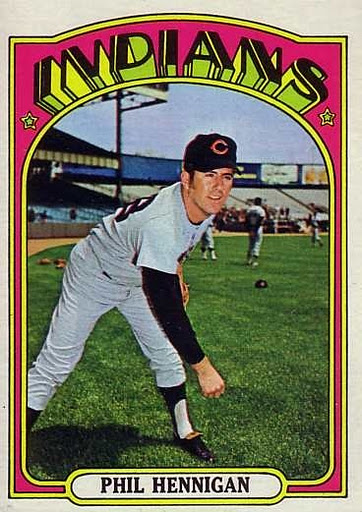

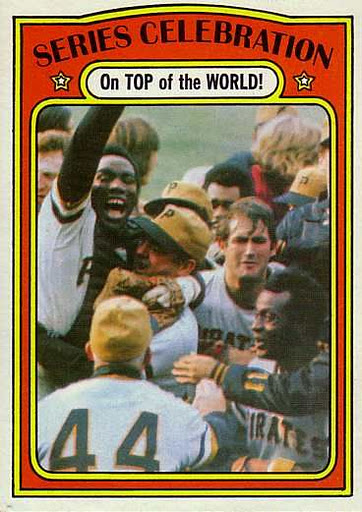


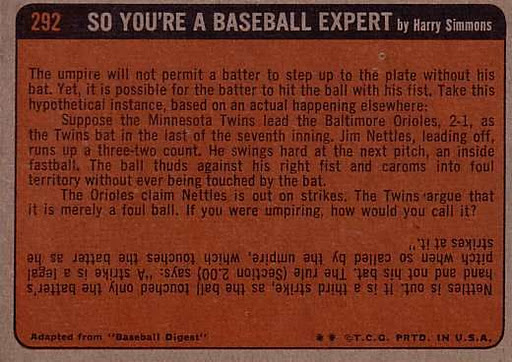


maybe the 72 set was ahead of its time in that nowadays, new era caps have exploded into never before seen colors that have no relation to traditional team emblems…orange yankee hats as an example.
but more importantly this is a great post and i am looking forward to the next one on 73. my favorite cards from this set 72 were the in action cards and the cooper fisk rookie card. huge cooper fan.
by the way, do you partake in trading of cards? i’m always interested in expos cards.
Thank you, Steven. You may a point about all the colorful caps, that’s for sure. I tend to jump around topic wise on Grubby Glove. In terms of reviewing sets, I have the 1963 Topps edition on deck, with the 1982 Donruss offering set in the hole.
Yes, I collect and trade baseball cards. I’ll email you very soon.
Thank you, Dan. The boyhood photos cards were in the 3rd + 4th series. I think I’ve got one or two duplicates. I would be happy to give it to you as a gift from one baseball blogger to another. Please let me know at your convenience.